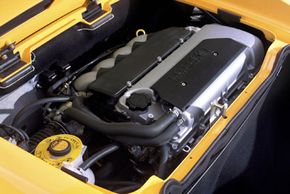A typical car in America has something around a 120-horsepower engine. A big SUV might have a 200-horsepower engine, and a tiny car might have only 70 horsepower. A moped, on the other hand has only a 1- or 2- horsepower engine, and it gets great gas mileage -- 70 or 80 miles per gallon. So why not put a little engine in a car to give its mileage a boost?
Car Engine Image Gallery
One reason is that a car needs a fair amount of power to make its way down the road. At 60 mph, a typical car needs 10 to 20 horsepower simply to maintain its speed. That energy level is needed to overcome wind resistance and the rolling resistance in the tires. If you have the headlights on, the alternator is using power to generate electricity for the lights. If the air conditioner is on, that takes power too. A 1-horsepower engine couldn't maintain more than 20 or 30 mph in a normal car, and you could never turn on the headlights or the air conditioning.
Advertisement
The other problem is acceleration. The bigger the engine, the faster you can accelerate from zero to 60mph. With a 1-horsepower engine, you might need a couple of minutes to accelerate up to 60mph, even if there was no such thing as wind resistance.
If you wanted to make a car that could run on a 1 horsepower engine, you would need to make it a tiny, lightweight, extremely aerodynamic one-seater. It would look more like a cold capsule than a car. By making it tiny and lightweight, you would be able to accelerate quickly even with limited power. Because it would be minuscule and aerodynamic, you would reduce its wind resistance so much that a 1-horsepower engine could keep it moving at 60 or 70 mph without any trouble. That would give you a high-mileage car.
Advertisement
